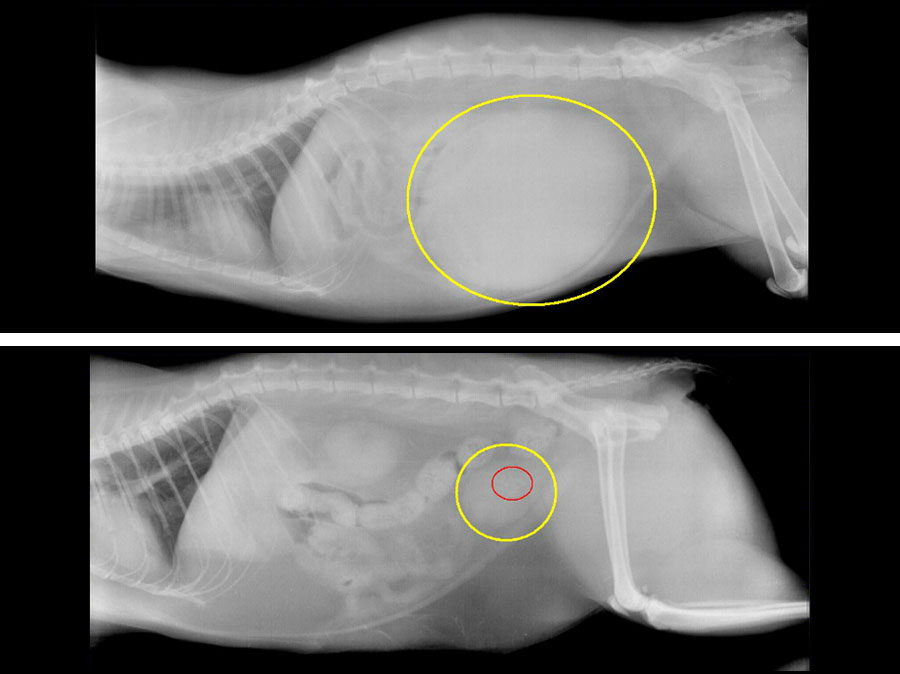Causes: There are various causes of UTI, such as crystals, that usually occur when the urine's pH is not acidic enough and they physically hurt the urinary bladder's wall and cause the inflammation, bacteriae and even stress. Bacterial infection is less common in cats than in dogs.
Besides a UTI, the clinical signs mentioned above can occur in other diseases of the urinary bladder such as trauma, polyps, tumors, neurological problems, structural problems, etc. Therefore, when we see a cat showing one or more of these clinical signs we perform several diagnostic tests.
Diagnosis:The diagnostic procedure will start with a full physical exam, during which we will palpate the kidneys and urinary bladder to see if they are painful and try to evacuate the urinary bladder by manually pressing it. Then we will collect urine <INSERT LINK> for a complete urinalysis where we will check different parameters, such as the urine's pH, its specific gravity and the presence of crystals, bacteriae and other cells by looking at the urine under the microscope. We prefer collecting the urine directly from the bladder with a syringe in order to get an accurate picture of the bladder's state without having the urine "contaminated" on its way down the urethra. In severe cases, e.g. when we suspect stones or a tumor, we will perform x-rays and/or and ultrasound examination. If the cat is old or in a poor state we will take blood for a blood test too.
Treatment: The treatment will be given based on the results of the different tests performed. In case of an inflammation caused by crystals we will treat with a special diet aimed at acidifying the urine and dissolving the crystals. If the UTI is caused by a bacterial infection we will treat with antibiotics. In cases of chronic or recurring infections we will choose the antibiotics based on a culture & sensitivity test. We will also use NADG, a drug that protects the inner lining of the urinary bladder, in almost every case of UTI.
There are times where the cat shows signs of a UTI but no cause (i.e. bacteriae, crystals, etc.) can be found. Such UTI are called FIC (Feline Idiopathic Cystitis, "feline urinary bladder inflammation of unknown origin"). FIC is probably caused by stress and is sometimes self-healing. The treatment of FIC consists of painkillers. No antibiotics or special food are required.
It is very important to emphasize!!! The urethra of male cats is relatively narrow and can be easily blocked by small stones, a "plug" of inflammatory cells, a blood clot, etc. For this reason male cats that suffer from a UTI are in danger of having their urethra blocked. In case of a urethral blockage urine cannot flow out of the body and results in great pressure in the bladder and therefore great pressure on the kidneys. When the kidneys are under such pressure they quickly "shut down" and cannot perform their important functions – getting rid of waste, regulate blood pressure, etc. This is a dangerous and life threatening condition!!!

X-rays of two cats (bladders are marked with yellow circles)
on the left: a blocked cat where the bladder had reached and enormous size
on the right: a normal size bladder but it has stones (red circle)
In cases of a urinary tract blockage the first thing we will do is to insert a urinary catheter through the urethra into the urinary bladder in order to push the cause of the block back to the urinary bladder and in order to empty the bladder and relieve the pressure. We will administer acidifiers to dissolve the blocking agent and administer IV fluids with electrolytes, painkillers and antibiotics. We will also use drugs to loosen the urethral sphincters and ease the flow of urine out of the bladder.
After the cat is discharged home we will monitor his urination and repeat the urinalysis in order to prevent recurrence.
If you noticed signs of UTI you should bring your cat in for an exam but if you suspect your cat is blocked you must have him examined immediately!

